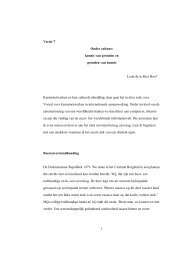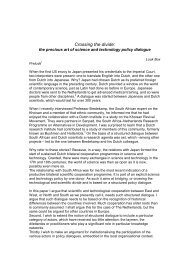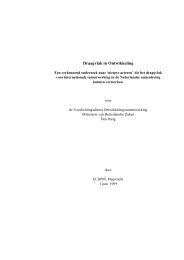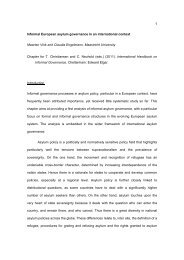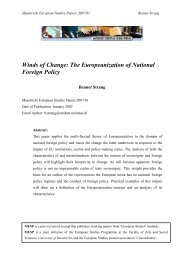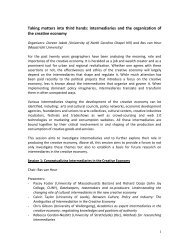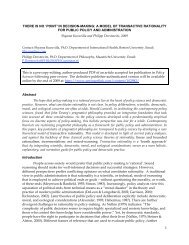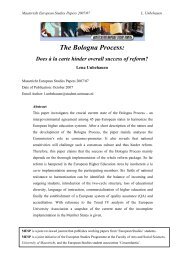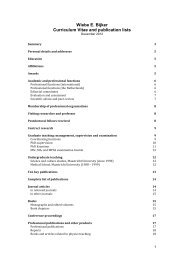the case of the synthetic dye industry, 1857–1914 - Maastricht ...
the case of the synthetic dye industry, 1857–1914 - Maastricht ...
the case of the synthetic dye industry, 1857–1914 - Maastricht ...
You also want an ePaper? Increase the reach of your titles
YUMPU automatically turns print PDFs into web optimized ePapers that Google loves.
200 J.P. Murmann and E. Homburg<br />
The most likely reasons why <strong>the</strong> number <strong>of</strong> firms did not decline at <strong>the</strong><br />
global level in <strong>the</strong> decade before World War I despite German dominance was<br />
that smaller producer countries enacted protectionist policies to aid domestic<br />
producers, and some entrepreneurs spotted niches that were not served by <strong>the</strong><br />
large producers. But this pattern should not distract from <strong>the</strong> overwhelming fact<br />
that German firms completely dominated <strong>the</strong> ever-growing market for syn<strong>the</strong>tic<br />
<strong>dye</strong>s.<br />
5 Classifying causal forces<br />
The context-specific accounts and <strong>the</strong> causes presented above can be reclassified<br />
into more general categories that can potentially be applied to o<strong>the</strong>r industries.<br />
The <strong>case</strong> <strong>of</strong> <strong>the</strong> syn<strong>the</strong>tic <strong>dye</strong> <strong>industry</strong> has shown that: 1) <strong>the</strong> same causal forces<br />
did not operate throughout <strong>the</strong> entire period from <strong>1857–1914</strong>, and 2) what happened<br />
in one country was not entirely independent <strong>of</strong> o<strong>the</strong>r countries since local<br />
firms <strong>of</strong>ten experienced competition from foreign rivals. As a simple methodological<br />
rule we conclude from our <strong>dye</strong> <strong>industry</strong> study that in comparing <strong>industry</strong><br />
evolution in different countries it is necessary to ascertain to what extent <strong>the</strong> different<br />
national industries are linked through trade and how key causal variables<br />
change over time. If <strong>the</strong> <strong>case</strong> <strong>of</strong> <strong>the</strong> <strong>dye</strong> <strong>industry</strong> generalizes to o<strong>the</strong>r industries,<br />
<strong>the</strong> following are promising candidates for key causal forces <strong>of</strong> <strong>industry</strong><br />
evolution:<br />
Legal environment<br />
It appears that <strong>the</strong> legal environment can act as a barrier or facilitator <strong>of</strong> entry<br />
into <strong>the</strong> <strong>industry</strong> and hence influence <strong>industry</strong> dynamics in fundamental ways. In<br />
<strong>the</strong> syn<strong>the</strong>tic <strong>dye</strong> <strong>industry</strong>, <strong>the</strong> differences in patent laws across countries shaped<br />
<strong>industry</strong> evolution by ei<strong>the</strong>r encouraging or discouraging <strong>the</strong> formation <strong>of</strong> new<br />
firms. While patent laws seem to have <strong>the</strong> uniform effect <strong>of</strong> reducing entry, <strong>the</strong><br />
competitive implications <strong>of</strong> patent laws depend on <strong>the</strong> <strong>industry</strong>’s level <strong>of</strong> development.<br />
Patent laws can ei<strong>the</strong>r help or hurt <strong>the</strong> competitive position <strong>of</strong> domestic<br />
firms, depending on <strong>the</strong> policies <strong>of</strong> o<strong>the</strong>r countries and <strong>the</strong> firms <strong>the</strong>rein. 28 In<br />
order for patent laws to have a competitive effect, <strong>the</strong>y obviously must vary<br />
across countries. Competition laws in countries can also have a direct effect on<br />
<strong>industry</strong> dynamics. The formation <strong>of</strong> cartels in <strong>the</strong> German <strong>dye</strong> <strong>industry</strong> was a<br />
mechanism to reduce competition between some <strong>of</strong> <strong>the</strong> large firms, especially<br />
after 1904. 29<br />
28 For a review <strong>of</strong> different <strong>the</strong>ories on <strong>the</strong> economic effects <strong>of</strong> patents, see Mazzoleni and Nelson<br />
(1998).<br />
29 At <strong>the</strong> end <strong>of</strong> 1925, <strong>the</strong> entire German <strong>dye</strong> <strong>industry</strong> was consolidated into one firm, I.G. Farbenindustrie<br />
(also known as IG Farben).



